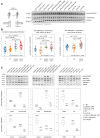In-depth mass-spectrometry reveals phospho-RAB12 as a blood biomarker of G2019S LRRK2-driven Parkinson's disease
- PMID: 39705401
- PMCID: PMC12129731
- DOI: 10.1093/brain/awae404
In-depth mass-spectrometry reveals phospho-RAB12 as a blood biomarker of G2019S LRRK2-driven Parkinson's disease
Abstract
Leucine-rich repeat kinase 2 (LRRK2) inhibition is a promising disease-modifying therapy for LRRK2-associated Parkinson's disease (L2PD) and idiopathic PD. However, pharmacodynamic readouts and progression biomarkers for clinical trials aiming for disease modification are insufficient, given that no endogenous marker reflecting enhanced kinase activity of the most common LRRK2 G2019S mutation has yet been reported in L2PD patients. Using phospho-/proteomic analyses, we assessed the impact of LRRK2-activating mutations in peripheral blood mononuclear cells from an LRRK2 clinical cohort from Spain (n = 174). The study groups encompassed G2019S L2PD patients (n = 37), non-manifesting LRRK2 mutation carriers of G2019S (here termed G2019S L2NMCs) (n = 27), R1441G L2PD patients (n = 14), R1441G L2NMCs (n = 11), idiopathic PD patients (n = 40) and healthy controls (n = 45). We identified 207 differentially regulated proteins in G2019S L2PD compared with controls (39 upregulated and 168 downregulated) and 67 in G2019S L2NMCs (10 upregulated and 57 downregulated). G2019S downregulated proteins affected the endolysosomal pathway, proteostasis and mitochondria, e.g. ATIC, RAB9A or LAMP1. At the phospho-proteome level, we observed increases in endogenous phosphorylation levels of pSer106 RAB12 in G2019S carriers, which were validated by immunoblotting after 1 year of follow-up (n = 48). Freshly collected peripheral blood mononuclear cells from three G2019S L2PD, one R1441G L2PD, one idiopathic PD and five controls (n = 10) showed strong diminishment of pSer106 RAB12 phosphorylation levels after in vitro administration of the MLi-2 LRRK2 inhibitor. Using machine learning, we identified an 18-feature G2019S phospho-/protein signature discriminating G2019S L2PD, L2NMCs and controls with 96% accuracy that was correlated with disease severity, i.e. UPDRS-III motor scoring. Using easily accessible peripheral blood mononuclear cells from a LRRK2 clinical cohort, we identified elevated levels of pSer106 RAB12 as an endogenous biomarker of G2019S carriers. Our data suggest that monitoring pSer106 RAB12 phosphorylation could be a relevant biomarker for tracking LRRK2 activation, particularly in G2019S carriers. Future work might determine whether pSer106 RAB12 could help with patient enrichment and monitoring drug efficacy in LRRK2 clinical trials.
Keywords: Parkinson’s disease; biomarker; leucine-rich repeat kinase 2; non-manifesting carriers; peripheral blood mononuclear cells; phospho-/proteomics.
© The Author(s) 2024. Published by Oxford University Press on behalf of the Guarantors of Brain.
Conflict of interest statement
The authors report no competing interests.
Figures






References
-
- Sheng Z, Zhang S, Bustos D, et al. Ser1292 autophosphorylation is an indicator of LRRK2 kinase activity and contributes to the cellular effects of PD mutations. Sci Transl Med. 2012;4:164ra161. - PubMed
-
- Zimprich A, Biskup S, Leitner P, et al. Mutations in LRRK2 cause autosomal-dominant parkinsonism with pleomorphic pathology. Neuron. 2004;44:601–607. - PubMed
MeSH terms
Substances
Grants and funding
LinkOut - more resources
Full Text Sources
Medical
Miscellaneous

